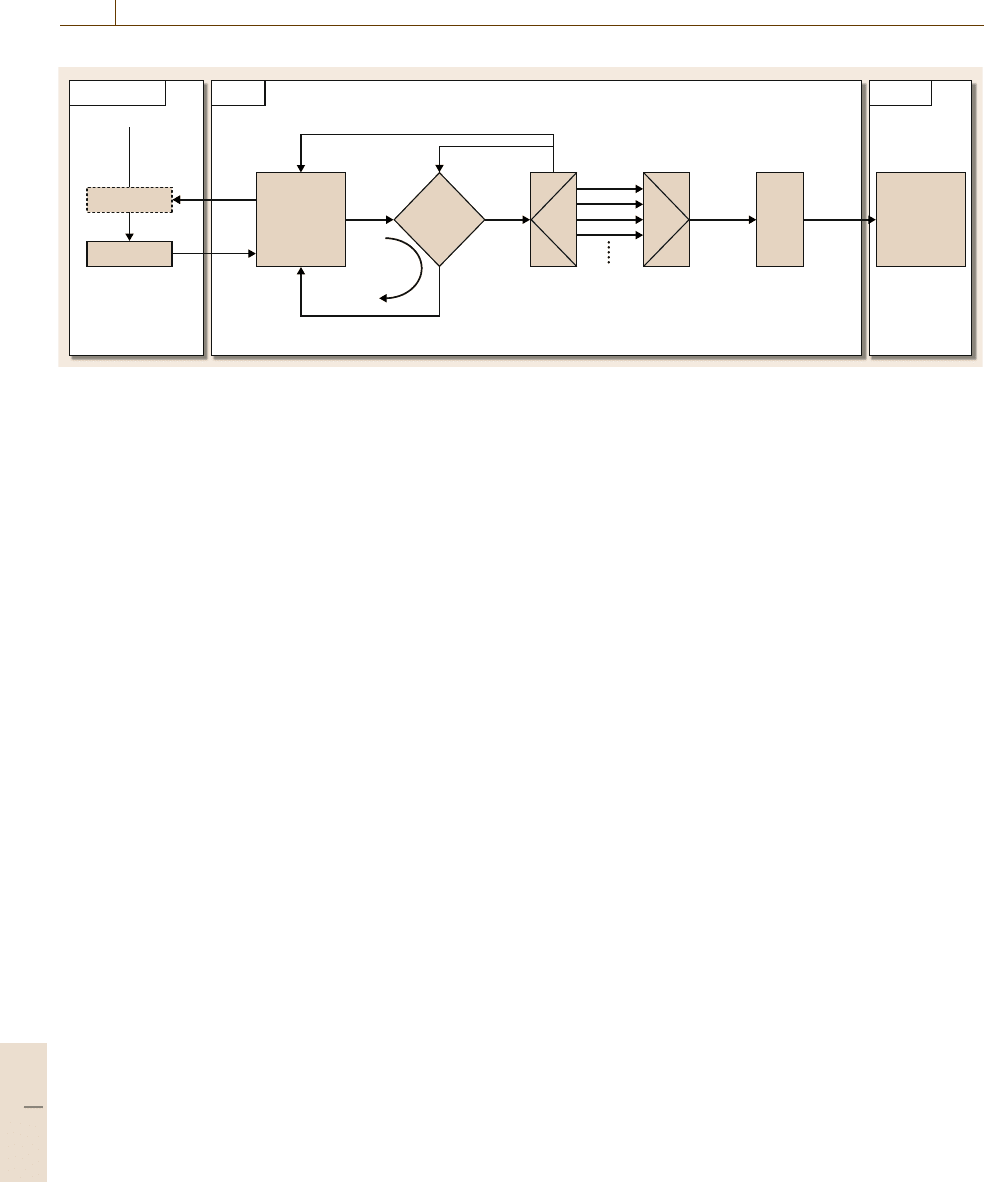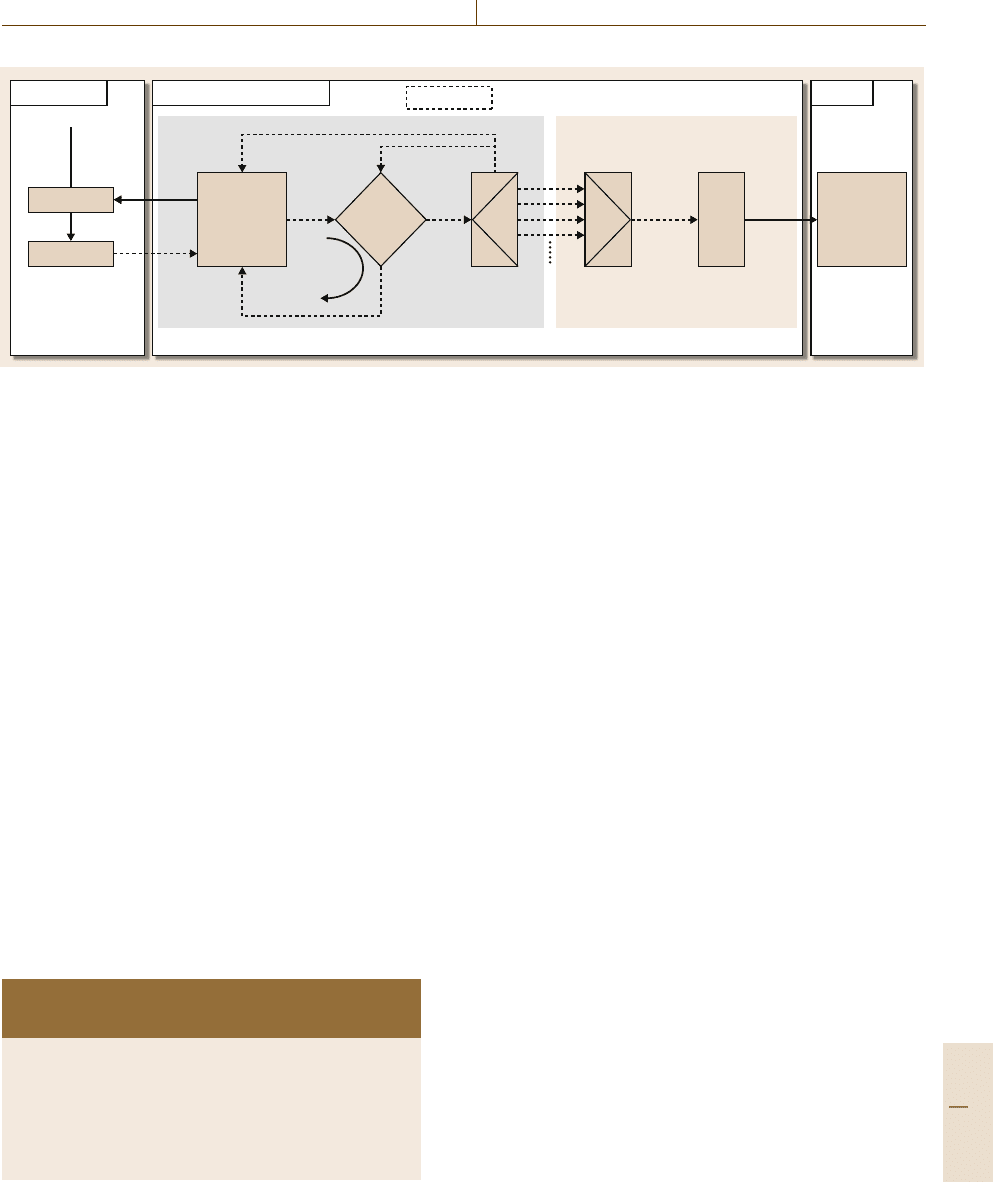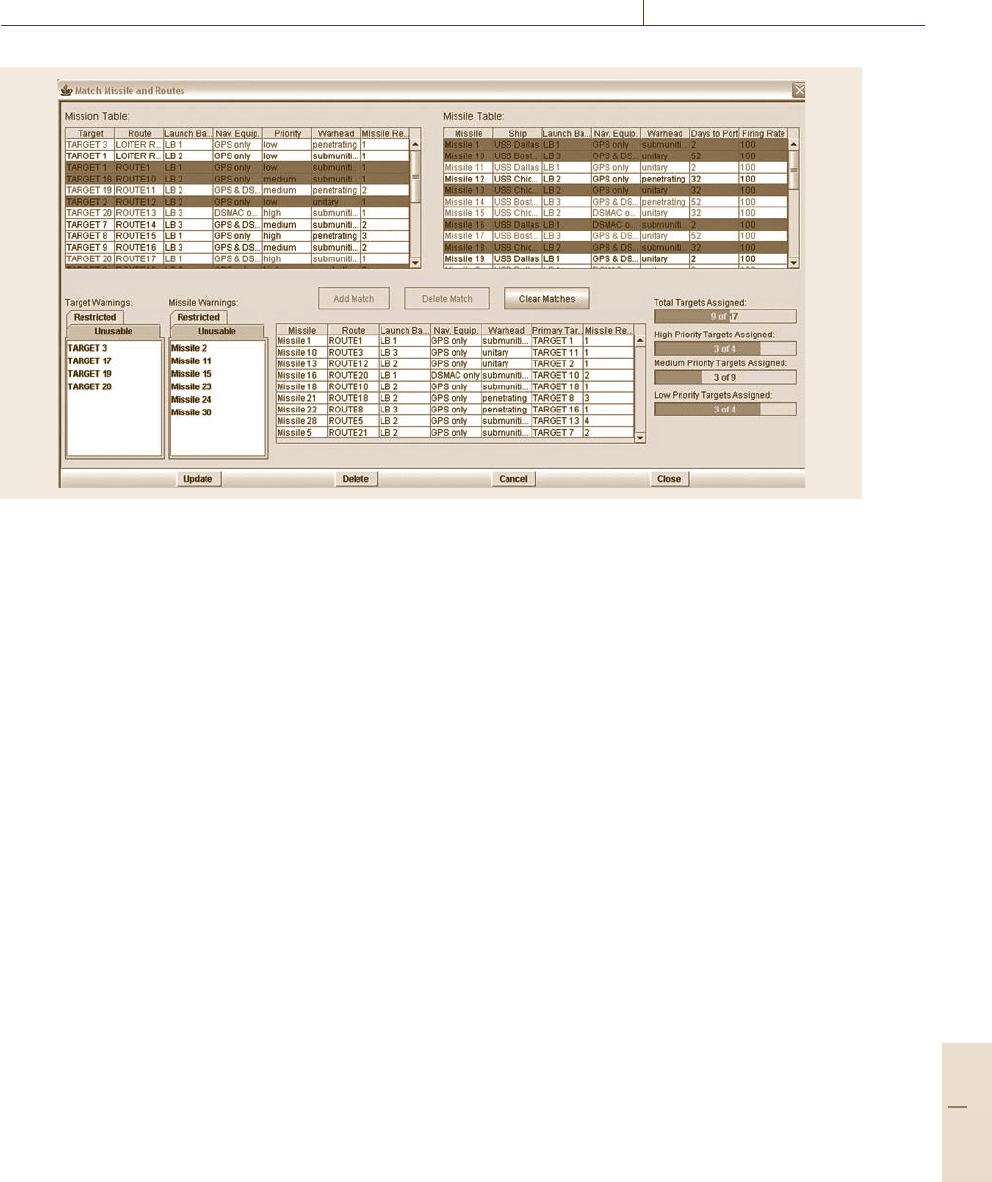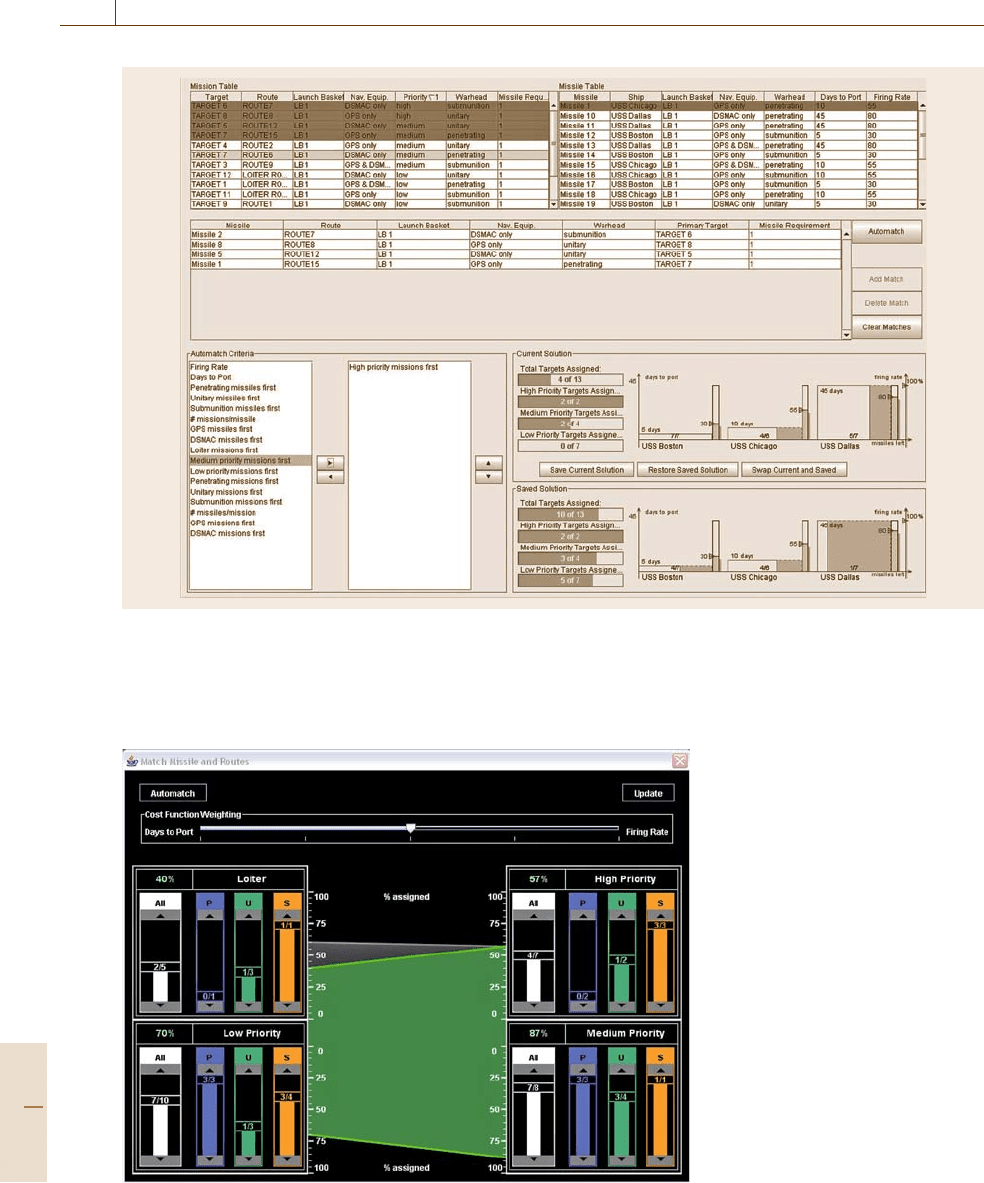Nof S.Y. Springer Handbook of Automation
Подождите немного. Документ загружается.


Human Factors in Automation Design References 435
effort,Int.J.Hum.-Comput.Stud.52(2), 289–318
(2000)
25.97 S.W.A. Dekker, D.D. Woods: MABA-MABA or abra-
cadabra? Progress on human-automation co-
ordination, Cogn. Technol. Work 4, 240–244 (2002)
25.98 E. Hollnagel, A. Bye: Principles for modelling func-
tion allocation, Int. J. Hum.-Comput. Stud. 52(2),
253–265 (2000)
25.99 A. Kirlik: Modeling strategic behavior in human–
automation interaction: Why an “aid” can (and
should) go unused, Hum. Factors 35(2), 221–242
(1993)
25.100 J.R. Anderson, C. Libiere: Atomic Components of
Thought (Lawrence Erlbaum, Hillsdale 1998)
25.101 M. D. Byrne, A. Kirlik: Using computational cog-
nitive modeling to diagnose possible sources of
aviation error, Int. J. Aviat. Psychol. 12(2), 135–155
25.102 A. Degani, A. Kirlik: Modes in human–automation
interaction: initial observations about a model-
ing approach, IEEE-Syst. Man Cybern. 4, 3443–3450
(1995)
25.103 A. Degani, M. Heymann: Formal verification
of human–automation interaction, Hum. Factors
44(1), 28–43 (2002)
25.104 D.A. Norman: The ‘problem’ with automation:
Inappropriate feedback and interaction, not ’over-
automation’, Philos. Trans. R. Soc. Lond. Ser. B,
Biol. Sci. 327(1241), 585–593 (1990)
25.105 E.B. Entin, E.E. Entin, D. Serfaty: Optimizing aided
target-recognition performance. In: Proc. Hum.
Factors Ergon. Soc. (Human Factors and Ergonomics
Society, Santa Monica 1996) pp. 233–237
25.106 A.E. Sklar, N.B. Sarter: Good vibrations: Tactile
feedback in support of attention allocation and
human-automation coordination in event-driven
domains, Hum. Factors 41(4), 543–552 (1999)
25.107 M.I. Nikolic, N.B. Sarter: Peripheral visual feed-
back: a powerful means of supporting effective
attention allocation in event-driven, data-rich
environments, Hum. Factors 43(1), 30–38 (2001)
25.108 B.D. Seppelt: Making the limits of adaptive cruise
control visible, Int. J. Hum.-Comput. Stud. 65,192–
205 (2007)
25.109 J.M. Flach: Ready, fire, aim: a “meaning-
processing” approach to display design. In:
Attention and Performance XVII: Cognitive Regu-
lation of Performance: Interaction of Theory and
Application,ed.byD.Gopher,A.Koriat(MITPress,
Cambridge 1999) pp. 197–221
25.110 S.A. Guerlain, G.A. Jamieson, P. Bullemer, R. Blair:
The MPC elucidator: a case study in the design for
human–automation interaction, IEEE Trans. Syst.
Man Cybern. Part A: Syst. Hum. 32(1), 25–40 (2002)
25.111 S. Tseng, B.J. Fogg: Credibility and computing tech-
nology, Commun. ACM. 42(5), 39–44 (1999)
25.112 P. Briggs, B. Burford, C. Dracup: Modeling self-
confidence in users of a computer-based system
showing unrepresentative design, Int. J. Hum.-
Comput. Stud. 49(5), 717–742 (1998)
25.113 B. Fogg, J. Marshall, O. Laraki, A. Osipovich,
N. Fang: What makes web sites credible? A report
on a large quantitative study, Proc. Chi Conf. Hum.
Fact. Comput. Syst. 2001 (ACM, Seattle 2001)
25.114 B. Fogg, J. Marshall, T. Kameda, J. Solomon,
A. Rangnekar, J. Boyd, B. Brown: Web credibil-
ity research: a method for online experiments and
early study results, Chi Conf. Hum. Fact. Comput.
Syst. (2001) pp. 293–294
25.115 V. Riley: A new language for pilot interfaces, Ergon.
Des. 9(2), 21–27 (2001)
25.116 M.A. Goodrich, E.R. Boer: Model-based human-
centered task automation: a case study in ACC
system design, IEEE Trans. Syst. Man Cybern. – Part
A: Syst. Hum. 33(3), 325–336 (2003)
25.117 C.A. Miller: Definitions and dimensions of eti-
quette. In: Etiquette for Human-Computer Work:
Technical Report FS-02-02, ed. by C. Miller (Amer-
ican Association for Artificial Intelligence, Menlo
Park 2002) pp. 1–7
25.118 C. Nass, K.N. Lee: Does computer-synthesized
speech manifest personality? Experimental tests of
recognition, similarity-attraction, and consistency-
attraction, J. Exp. Psychol.-Appl. 7(3), 171–181 (2001)
25.119 K.J. Vicente: Coherence- and correspondence-
driven work domains: implications for systems
design, Behav. Inf. Technol. 9, 493–502 (1990)
25.120 R.A. Brooks, P. Maes, M.J. Mataric, G. More: Lunar
base construction robots, Proc. 1990 Int. Workshop
Intell. Robots Syst. (1990) pp. 389–392
25.121 P.J. Johnson, J.S. Bay: Distributed control of sim-
ulated autonomous mobile robot collectives in
payload transportation, Auton. Robots 2(1), 43–63
(1995)
25.122 R.A. Brooks, A.M. Flynn: A robot being. In: Robots
and Biological Systems: Towards a New Bionics,
ed.byP.Dario,G.Sansini,P.Aebischer(Springer,
Berlin 1993)
25.123 G. Beni, J. Wang: Swarm intelligence in cellular
robotic systems. In: Robots and Biological Systems:
Towards a New Bionics, ed. by P. Dario, G. Sansini,
P. Aebischer (Springer, Berlin 1993)
25.124 T. Fukuda, D. Funato, K. Sekiyama, F. Arai: Eval-
uation on flexibility of swarm intelligent system,
Proc. 1998 IEEE Int. Conf. Robotics Autom. (1998)
pp. 3210–3215
25.125 K. Sugihara, I. Suzuki: Distributed motion coor-
dination of multiple mobile robots, 5th IEEE Int.
Symp. Intell. Control (1990) pp. 138–143
25.126 T.W. Min, H.K. Yin: A decentralized approach for
cooperative sweeping by multiple mobile robots,
Proc. 1998 IEEE/RSJ Int. Conf. Intell. Robots Syst.
(1998)
25.127 E.S. Patterson: A simulation study of computer-
supported inferential analysis under data over-
Part C 25

436 Part C Automation Design: Theory, Elements, and Methods
load, Proc. Hum. Factors Ergon. 43rd Annu. Meet.,
Vol. 1 (1999) pp. 363–368
25.128 P. Pirolli, S. Card: Information foraging, Psychol.
Rev. 106(4), 643–675 (1999)
25.129 J. Murray, Y. Liu: Hortatory operations in highway
traffic management, IEEE Trans. Syst. Man Cybern.
–PartA:Syst.Hum.27(3), 340–350 (1997)
25.130 T.R. Stickland, N.F. Britton, N.R. Franks: Com-
plex trails and simple algorithms in ant foraging,
260(1357), 53–58 (1995)
25.131 M. Resnick: Turtles, Termites, and Traffic Jams: Ex-
plorations in Massively Parallel Microworlds (MIT
Press, Cambridge 1991)
25.132 J.D. Lee: Emerging challenges in cognitive er-
gonomics: Managing swarms of self-organizing
agent-based automation, Theor. Issues Ergon. Sci.
2(3), 238–250 (2001)
25.133 T.C. Schelling: Micro Motives and Macro Behavior
(Norton, New York 1978)
25.134 J.H. Dyer, H. Singh: The relational view: cooper-
ative strategy and sources of interorganizational
competitive advantage, Acad. Manag. Rev. 23(4),
660–679 (1998)
25.135 J.D. Sterman: Modeling managerial behavior:
misperceptions of feedback in a dynamic decision-
making experiment, Manag. Sci. 35(3), 321–339
(1989)
25.136 X.D. Zhao, J.X. Xie: Forecasting errors and the value
of information sharing in a supply chain, Int. J.
Prod. Res. 40(2), 311–335 (2002)
25.137 H.L. Lee, S.J. Whang: Information sharing in a sup-
ply chain, Int. J. Technol. Manag. 20(3-4), 373–387
(2000)
25.138 H. Akkermans, K. van Helden: Vicious and virtuous
cycles in ERP implementation: a case study of in-
terrelations between critical success factors, Eur. J.
Inf. Syst. 11(1), 35–46 (2002)
25.139 R.B. Handfield, C. Bechtel: The role of trust and
relationship structure in improving supply chain
responsiveness, Ind. Mark. Manag. 31(4), 367–382
(2002)
25.140 J. Gao, J.D. Lee: Extending the decision field theory
to model operators’ reliance on automation in su-
pervisory control situations, IEEE Syst. Man Cybern.
36(5), 943–959 (2006)
25.141 J.R. Busemeyer, J.T. Townsend: Decision field the-
ory: A dynamic cognitive approach to decision
making in an uncertain environment, Psychol. Rev.
100(3), 432–459 (1993)
25.142 T.S.Zhou,J.H.Lu,L.N.Chen,Z.J.Jing,Y.Tang:On
the optimal solutions for power flow equations,
Int. J. Electr. Power Energy Syst. 25(7), 533–541
(2003)
25.143 T. Mulkerin: Free flight is in the future – large-scale
controller pilot data link communications emula-
tion testbed, IEEE Aerosp. Electron. Syst. Mag. 18(9),
23–27 (2003)
25.144 W.A. Olson, N.B. Sarter: Management by consent in
human-machine systems: when and why it breaks
down, Hum. Factors 43(2), 255–266 (2001 )
Part C 25

437
Collaborative
26. Collaborative Human–Automation
Decision Making
Mary L. Cummings, Sylvain Bruni
The development of a comprehensive collabora-
tive human–computer decision-making model is
needed that demonstrates not only what decision-
making functions should or could be assigned to
humans or computers, but how many functions can
best be served in a mutually supportive environ-
ment in which the human and computer collabo-
rate to arrive at a solution superior to that which
either would have come to independently. To this
end, we present the human–automation collabo-
ration taxonomy (HACT),whichbuildsonprevious
research by expanding the Parasuraman infor-
mation processing model [26.1], specifically the
decision-making component. Instead of defining
a simple level of automation for decision making,
we deconstruct the process to include three dis-
tinct roles: the moderator, generator, and decider.
We propose five levels of collaboration (LOCs) for
26.1 Background ......................................... 438
26.2 The Human–Automation Collaboration
Taxonomy (HACT) .................................. 439
26.2.1 Three Basic Roles.......................... 440
26.2.2 Characterizing Human Supervisory
Control System Collaboration ......... 442
26.3 HACT Application and Guidelines ............ 442
26.4 Conclusion and Open Challenges ............ 445
References .................................................. 446
each of these roles, which form a three-tuple that
can be analyzed to evaluate system collaboration,
and possibly identify areas for design intervention.
A resource allocation mission planning case study
is presented using this framework to illustrate the
benefit for system designers.
In developing any complex supervisory control system
that involves the integration of human decision making
with automation, the question often arises as to where,
how, and how much humans should be in the decision-
making loop. Allocating roles and functions between
the human and the computer is critical in defining effi-
cient and effective system architectures. However, role
allocation does not necessarily need to be mutually
exclusive,and insteadof systemsthat clearlydefine spe-
cific roles for either human or automation, it is possible
that humans and computers can collaborate in a mu-
tually supportive decision-making environment. This is
especially truefor aspectsof supervisory control that in-
clude planning andresource allocation(e.g., how should
multiple aircraft be routed to avoid bad weather, or how
to allocate ambulances in a disaster), which is the fo-
cus of this chapter. For discussion purposes, we define
collaboration as the mutual engagement of agents in
a coordinated and synchronous effort to solve a prob-
lem based on a shared conception of it [26.2, 3]. We
define agents as either humans or some form of automa-
tion/computer that provides some level of interaction.
For planning and resource allocation supervisory
control tasks in complex systems, the problem spaces
are large with significant uncertainty, so the use of au-
tomation is clearly warranted in attempting to solve
a particular problem; for example, if bad weather
prevents multiple aircraft from landing at an air-
port, air-traffic controllers need to know right away
which alternate airports are within fuel range, and of
these, which have the ability to service the different
aircraft types, the predicted traffic volume, routing con-
flicts, etc. While automation could be used to provide
optimized routing recommendations quickly, computer-
generated solutions are unfortunately not always the
best solutions. While fast and able to handle complex
computation far better than humans, computer opti-
mization algorithms are notoriously brittle in that they
Part C 26

438 Part C Automation Design: Theory, Elements, and Methods
can only take into account those quantifiable variables
identified in the design stages that were deemed to
be critical [26.4]. In supervisory control systems with
inherent uncertainties (weather impacts, enemy move-
ment, etc.), it is not possible to include a priori every
single variable that could impact the final solution.
Moreover, it is not clear exactly what characterizes an
optimal solution in uncertain such scenarios. Often, in
these domains, the need to generate an optimal solution
should be weighed against a satisficing [26.5] solution.
Because constraints and variables are often dynamic in
complex supervisory control environments, the defini-
tion of optimal is also a constantly changing concept.
In those cases of time pressure, having a solution that
is good enough, robust, and quickly reached is often
preferable to one that requires complex computation
and extended periods of times, which may not be ac-
curate due to incorrect assumptions.
Recognizing the need for automation to help nav-
igate complex and large supervisory control problem
spaces, it is equally important to recognize the crit-
ical role that humans play in these decision-making
tasks. Optimization is a word typically associated with
computers but humans are natural optimizers as well,
although not necessarily in the same linear vein as
computers. Because humans can reason inductively and
generate conceptual representations based on both ab-
stract and factual information, they also have the ability
to optimize based on qualitative and quantitative in-
formation [26.6]. In addition, allowing operators active
participation in decision-making processes provides not
only safety benefits, but promotes situation awareness
and also allows a human operator, and thus a system,
to respond more flexibly to uncertain and unexpected
events. Thus, decision support systems that leverage the
collaborative strength of humans and automation in su-
pervisory control planningand resource allocation tasks
could provide substantial benefits, both in terms of hu-
man and system performance,
Unfortunately, little formal guidance exists to aid
designers and engineers in the development of col-
laborative human–computer decision support systems.
While many frameworks have been proposed that de-
tail levels of human–automation role allocation, there
has been no focus on what specifically constitutes col-
laboration in terms of role allocation and how this
can be quantified to allow for specific system analysis
as well as design guidance. Therefore, to better de-
scribe human-collaborative decision support systems in
order to provide more detailed design guidance, we
present the human–automation collaboration taxonomy
(HACT) [26.7].
26.1 Background
There is little previous literature that attempts to
classify, describe, or provide design guidance on
human–automation (or computer) collaboration. Most
previous efforts have generally focused on developing
application-specific decision support tools that promote
some open-ended form of human–computer interac-
tion (e.g., [26.8–10]). In an attempt to categorize
human–computer collaboration more formally, Silver-
man [26.11] proposed categories of human–computer
interaction in terms of critiquing, although this is
a relatively narrow field of human–computer col-
laboration. Terveen [26.12] attempted to seek some
unified approach and more broadly define and cat-
egorize human–computer collaboration in terms of
human emulation and human “complementary” [sic].
Beyond these broad definitions and categorizations of
human–computer collaborationand narrow applications
of specific algorithms and visualizations, there has been
no underlying theory addressing how collaborationwith
an automated agent supports operator decision mak-
ing at the most fundamental information processing
level.
So while the literature on human–automation col-
laboration in decision making is sparse, the converse
is true in terms of scales and taxonomies of au-
tomation levels that describe interactions between
a human operator and a computer/automation. These
levels of automation (LOAs) generally refer to the
role allocation between automation and the human,
particularly inthe analysis and decision phasesof a sim-
plified information processing model of acquisition,
analysis, decision, and action phases [26.1, 13, 14].
The originators of the concept of levels of automa-
tion, Sheridan and Verplank (SV), initially proposed
that automation could range from a fully manual
system with no computer intervention to a fully au-
tomated system where the human is kept completely
out of the loop [26.15]. Parasuraman [26.1]ex-
panded the original SV LOA to include ten levels
(Table 26.1).
Part C 26.1

Collaborative Human–Automation Decision Making 26.2 The Human–Automation Collaboration Taxonomy (HACT) 439
Table 26.1 Levels of automation (after [26.1,15])
Automation level Automation description
1 The computer offers no assistance: human must take all decision and actions
2 The computer offers a complete set of decision/action alternatives, or
3 Narrows the selection down to a few, or
4 Suggests one alternative, and
5 Executes that suggestion if the human approves, or
6 Allows the human a restricted time to veto before automatic execution, or
7 Executes automatically, then necessarily informs humans, and
8 Informs the human only if asked, or
9 Informs the human only if it, the computer, decides to
10 The computer decides everything and acts autonomously, ignoring the human
At the lower levels, LOAs 1–4, the human is
actively involved in the decision-making process. At
level 5, the automation takes on a more active role in ex-
ecuting decisions, while still requiring consent from the
operator before doing so (known as management-by-
consent). Level 6, typically referred to as management-
by-exception, allows the automation a more active role
in decisions, executing solutions unless vetoed by the
human. For levels 7–10, humans are only allowed
to accept or veto solutions presented to them. Thus,
as levels increase, the human is increasingly removed
from the decision-making loop, and the automation is
increasingly allocated additional authority. This scale
addresses primarily authority allocation, i.e., who is
given the authority to make the final decision, al-
though only to a much smaller and limited degree does
it address the solution-generation aspect of decision
making, which is a critical aspect of human–computer
collaboration.
The solution-generation process in supervisory con-
trol planning and resource allocation tasks is critical
because this is the aspect of the human–computer in-
teraction where the variables and constraints can be
manipulated to determine solution alternatives. This ac-
cess creates a sensitivity analysis tradespace that allows
human operators the ability to cope with uncertainty
and apply judgment and experience that are unavailable
to computer algorithms. While the LOAsinTable26.1
provide some indirect guidance as to how the solution-
generation process can be allocated either to the human
or computer, it is only tangentially inferred, and there is
no level that allows for joint construction or modifica-
tion of solutions.
Other LOA taxonomies have addressed the need
to examine authority and solution generation LOAs,
although none have addressed them in an integrated
fashion; for example, Endsley [26.16] incorporated ar-
tificial intelligence into a five-point LOA scale, thus
addressing some aspects of solution generation and
authority. Riley [26.17] investigated the use of the
level of information attribute in addition to the au-
tomation authority attribute, creating a two-dimensional
scale. Another ten-point scale was created by Ends-
ley and Kaber [26.16] where each level corresponds
to a specific task behavior of the automation, going
from manual control to full automation, through in-
termediate levels such as blended decision making or
supervisory control. While all of these scales acknowl-
edge that there are possible collaborative processes
between humans and automated agents, none specif-
ically detail how this interaction can occur, and how
different attributes of a collaborative system can each
have a different LOA. To address this shortcoming in
the literature, we developed the human–automation col-
laboration taxonomy (HACT), which is detailed in the
next section.
26.2 The Human–Automation Collaboration Taxonomy (HACT)
In order to better understand how human operators
and automation collaborate, the four-stage information-
processing flow diagram of Parasuraman [26.1] (with
stages: information acquisition, information analysis,
Part C 26.2

440 Part C Automation Design: Theory, Elements, and Methods
Feasible
solutions
presented
(1 to n)
Selected
solution
(0 to 1)
Final
solution
(0 to 1)
Element of
solution
Data
Evaluation
Eval. Veto
Data
analysis +
request
Solution
imple-
mentation
Data acqu. Action
DMP
Sensors
World
Data
Sub-decisions
Fig. 26.1 The HACT collaborative information-processing model
decision selection, and action implementation) was
modified to focus specifically on collaborative decision
making. This new model, shown in Fig.26.1, features
three steps: data acquisition, decision making, and ac-
tion taking. The data acquisition step is similar to that
proposed by Parasuraman [26.1] in that sensors retrieve
information from the outside world or environment, and
transform it into working data. The collaborative aspect
of this model occurs in the next stage, the decision-
making process, which corresponds to the integration
of the analysis and decision phases of the Parasura-
man [26.1] model.
First, the data from the acquisition step is analyzed,
possibly in an iterative way where requests for more
data can be sent to the sensors. The data analysis outputs
some elements of a solution to the problem at hand. The
evaluation block estimates the appropriateness of these
elements of solutions for a potential final solution. This
block may initiate a recursive loop with the data ana-
lysis block; for instance, operators may request more
analysis of the domain space or part thereof. At this
level, subdecisions are made to orient the search and
analysis process. Once the evaluation step is validated,
i.e., subdecisions are made, the results are assembled
to constitute one or more feasible solutions to the prob-
lem. In order to generate feasiblesolutions, itis possible
to loop back to the previous evaluation phase, or even
to the data analysis step. At some point, one or more
feasible solutions are presented in a second evaluation
step.
The operator or automation (depending on the level
of automation) will then select one solution (or none)
out of the pool of feasible solutions. After this selection
procedure, a veto step is added, since it is possible for
one or more of the collaborating agents to veto the solu-
tion selected (suchas inmanagement-by-exception).An
agent may be a human operator or an automated com-
puter system, also called automation. If the proposed
solution is vetoed, the output of the veto step is empty,
and the decision-making process starts again. If the se-
lected solution is not vetoed, it is considered the final
solution and is transferred to the action mechanism for
implementation.
26.2.1 Three Basic Roles
Given the decision-making process (DMP)shown
in Fig.26.1, three key roles have been identified:
moderator, generator, and decider. In the context of
collaborative human–computer decision making, these
three roles are fulfilled either by the human operator, by
automation, or by a combination of both. Figure 26.2
displays how these three basic roles fit into the HACT
collaborative information-processing model. The gen-
erator and the decider roles are mutually exclusive in
that the domain of competency of the generator (as out-
lined in Fig.26.2) does not overlap with that of the
decider. However, the moderator’s role subsumes the
entire decision-making process. As will be discussed,
each of the three roles has its own possible LOA scale.
The Moderator
The moderator is the agent(s) that keeps the decision-
making process moving forward, and ensures that the
various phases are executed; for instance, the moderator
may initiate the decision-making process and interac-
tion between the human and automation. The moderator
may prompt or suggest that subdecisions need to be
made, or evaluations need to be considered. It could
also be involved keeping the decision processing within
Part C 26.2

Collaborative Human–Automation Decision Making 26.2 The Human–Automation Collaboration Taxonomy (HACT) 441
Feasible solutions
presented
(1 to n)
Selected
solution
(0 to 1)
Final
solution
(0 to 1)
Element of
solution
Data
Evaluation
Eval. Veto
Data
analysis +
request
Solution
imple-
mentation
Data acqu. Action
Decision-making process
Moderator
Generator
Sensors
World
Data
Sub-decisions
Decider
Fig. 26.2 The three collaborative decision-making process roles: moderator, generator, and decider
prespecified limits when time pressure is a concern. In
relation to the ten-level SV LOA scale (Table 26.1),
the step between LOA 4 and 5 implies this role, but
does not address the fact that moderation can occur
across multiple segments of the decision-making pro-
cess and separate from the tasks of solution generation
and selection.
The Generator
The generator is the agent(s) that generates feasible
solutions from the data. Typically, the generator role in-
volves searching, identifying, and creating solution(s)
or parts thereof. Most of the previously discussed LOAs
(e.g., [26.1,16]) address the role of a solution generator.
However, instead of focusing ononly the actual solution
(e.g., automation generating one or many solutions), we
expand in detail the notion of the generator to include
other aspects of solution generation, i.e., all the other
steps within the generator box (Fig.26.2), such as the
automation analyzing data, which makes the solution
generation easier for the human operator. Additionally,
the role allocationfor generator may not bemutually ex-
clusive but could be shared to varying degrees between
Table 26.2 Moderator and generator levels
Level Who assumes the role of generator
and/or moderator?
2Human
1 Mixed, but more human
0 Equally shared
−1 Mixed, but more automation
−2 Automation
the human operator and the automation; for example, in
one system the human could define multiple constraints
and the automation searches for a set of possible solu-
tions bounded by these constraints. In another system,
the automation could propose a set of possible solu-
tions and then the human operator narrows down these
solutions.
For both the moderator and generator roles, the
general LOAs can be seen in Table 26.2,whichwe
recharacterize as LOCs (levels of collaboration). While
the levels could be parsed into more specific levels, as
seen in previously discussed LOAs, these five levels
were chosen to reflect degrees of collaboration with the
center scale reflecting balanced collaboration. At either
end of the LOC scale (2 or −2), the system, in terms
of moderation and generation, is not collaborative. The
negative sign should not be interpreted as a critical re-
flection on the use of automation; it simply reflects
scaling in the opposite direction. A system at LOC 0,
however, is a balanced collaborative system for either
the moderator and/or generator.
The Decider
The third role within the HACT collaborative decision-
making process is the decider. The decider is the
agent(s) that makes the final decision, i.e., that selects
the potentially final solution out of the set of feasible
solutions presented by the generator, and who has veto
power over this selection decision. Veto power is a non-
negotiableattribute: once an agent vetoes adecision, the
other agent cannot supersede it. This veto power is also
an important attribute in other LOA scales [26.1, 16],
but we have added more resolution to the possible role
allocations in keeping with our collaborative approach,
listed in Table 26.3.AsinTable26.2, the most balanced
Part C 26.2

442 Part C Automation Design: Theory, Elements, and Methods
Level Who assumes the role of decider?
2 Human makes final decision, automation cannot veto
1 Human or automation can make final decision,
human can veto, automation cannot veto
0 Human or automation can make final decision,
human can veto, automation can veto
−1 Human or automation can make final decision,
human cannot veto, automation can veto
−2 Automation makes final decision, human cannot veto
Table 26.3 Decider levels
collaboration between the human and the automation is
seen at the midpoint, with the greatest lack of collabo-
ration at the extreme levels.
The three roles, moderator, generator and decider,
focus on the tasks or actions that are undertaken by
the human operator, the automation, or the combina-
tion of both within the collaborative decision-making
process.
26.2.2 Characterizing Human Supervisory
Control System Collaboration
Given the scales outlined above, decision support sys-
tems can be categorized by the collaboration across
the three different roles (moderator, generator, and de-
cider) in the form of a three-tuple, e.g., (2, 1, 2) or
(−2, −2, 1). In the first example of (2, 1, 2), this sys-
tem includes the human as both the moderator and the
decider, as well as generating most of the solution, but
leverages some automation for the solution generation.
An example of such a system would be one where an
operator needs to plan a mission route but must select
not just the start and goal state, but all intermediate
points in order to avoid all restricted zones and possi-
ble hazards. Automation is used to ensure fuel limits
are not exceeded and to alert the operator in the case of
any area violations.
This is in contrast to the highly automated
(−2, −2, 1) example, which is the characterization of
the Patriot missile system. This antimissile missile sys-
tem notifies the operator that a target has been detected,
allows the operator approximately 15s to veto the au-
tomation’s solution, and then fires if the human does
not intervene. Thus the automation moderates the flow,
analyzes the solution space, presents a single solution,
and then allows the human to veto this. Note that un-
der the ten LOAsinTable26.1, this system would be
characterized at LOA 6, but the HACT three-tuple pro-
vides much more information. It demonstrates that the
system is highly automated at the moderator and gener-
ator levels, while the human has more authority than the
automation for the final decision. However, a low de-
cider level does not guarantee a human-centered system
in that the Patriot system has accidentally killed three
North Atlantic Treaty Organization (NATO)airmenbe-
cause operators were not able to determine in the 15s
window that the targets were actually friendly aircraft
and not enemy missiles. This example illustrates that all
three entries in the HACT taxonomy are important for
understanding a system’s collaborative potential.
26.3 HACT Application and Guidelines
In order to illustrate the application and utility of
HACT, a case study is presented. Given the increased
complexity, uncertainty, and time pressure of mission
planning and resource allocation in command and con-
trol settings, increased automation is an obvious choice
for system improvement. However just what level of
automation/collaboration should be used in such an ap-
plication is not so obvious. As previously mentioned,
too much automation can induce complacency and loss
of situation awareness, and coupled with theinherent in-
ability of automated algorithms to be perfectly correct
in dynamic command and control settings, high levels
of automation are not advisable. However, low levels
of automation can cause unacceptable operator work-
load as well as suboptimal, very inefficient solutions.
Thus the resource allocation aspect of mission planning
Part C 26.3

Collaborative Human–Automation Decision Making 26.3 HACT Application and Guidelines 443
Fig. 26.3 Interface 1
is well suited for some kind of collaborative human–
computer environment. To investigate this issue, three
interfaces were designed for a representative system,
each with a different LOA/LOC detailed in the next
section.
The general objective of this resource allocation
problem is for an operator to match a set of military
missions with a set of available resources, in this case
Tomahawk missiles aboard ship and submarine launch
platforms.
Interface 1 (Fig.26.3) was designed to support
manual matching of the missiles to the missions at
a low level of collaboration. This interface provides
raw data tables with all the characteristics of mis-
sions and missiles that must be matched, but only
provides very limited automated support, such as ba-
sic data sorting, mission/missile assignment summaries
by categories, and feedback on mission–missile incom-
patibility and current assignment status. Therefore, this
interface mostly involves manual problem solving. As
a result, interface 1 is assigned a level 2 moderator be-
cause the human operator fully controls the process.
Because interface 1 only features basic automation sup-
port, the generator role is at level 1. The decider is
at level 2 since only the human operator can validate
a solution for further implementation, with no possible
automation veto.
Interface 2 (Fig. 26.4) was designed to offer the
human operator the choice to either solve the mission–
missile assignment task manually as in interface 1 (note
in Fig.26.4 that the top part of interface 2 is a replica
of interface 1 shown in Fig.26.3), or to leverage au-
tomation and collaborate with the computer to generate
solutions. In the latter instance, termed Automatch,
the human operator can steer the search of the auto-
mated solution in the domain space by selecting and
prioritizing search criteria. Then, the automation’s fast
computing capabilities perform a heuristic search based
on the criteria defined by the human. The operator can
either keep the solution output or modify it manually.
The operator can also elect to modify the search criteria
to get a new solution.
Therefore, for interface 2, the moderator remains at
level 2 because the human operator is still in full con-
trol ofthe process, including which tasks are completed,
at what pace, and in which order. Because of the flex-
ibility in obtaining a solution in that the human can
define the search criteria, thus orienting the automation
which does the bulk of the computation, the generator
is labeled 0. The decider is at level 2 since only the
human operator can validate a final solution, which the
automation cannot veto.
While interfaces 1 and 2 are both based on the use
of raw data, interface 3 (Fig.26.5) is completely graph-
ical, and allows the operator to only have access to
postsolution sensitivity analysis tools. For interface 2,
the automated solution process is guided by the human,
who also can conduct sensitivity analysis via an Au-
Part C 26.3

444 Part C Automation Design: Theory, Elements, and Methods
Fig. 26.4 Interface 2
tomatch function; the Automatch button at the top of
interface 3 is similar to that in interface 2. However,
the user can only select a limited subset of information
Fig. 26.5 Interface 3
criteria by which to orient the algorithmic search, caus-
ing the operator to rely more on the automation than
in interface 2. Thus the HACT three-tuple in this case
Part C 26.3
